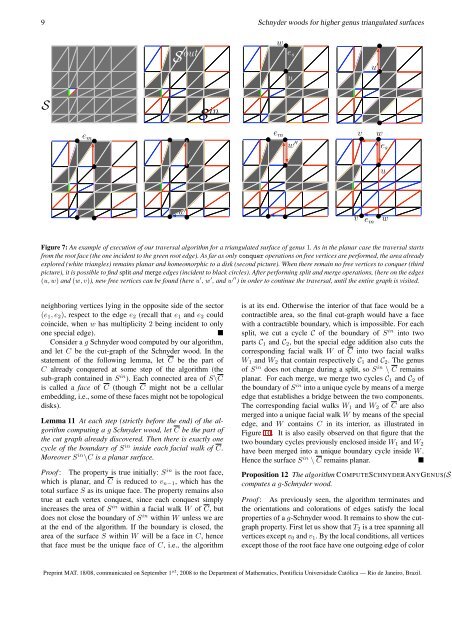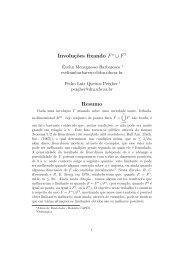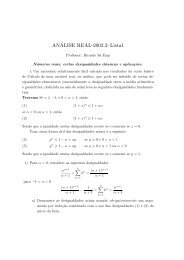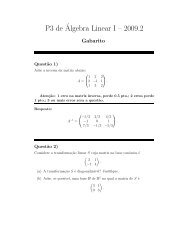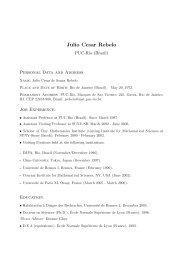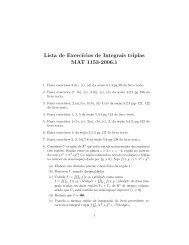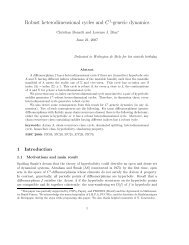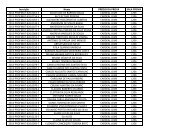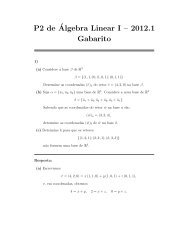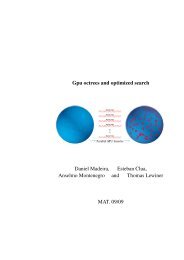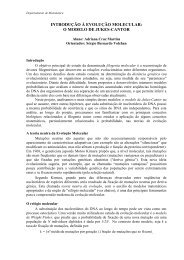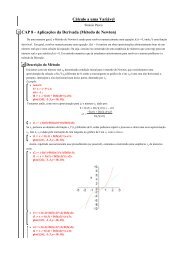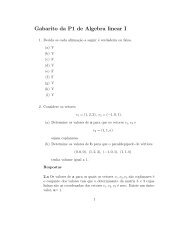Schnyder woods for higher genus triangulated surfaces with ...
Schnyder woods for higher genus triangulated surfaces with ...
Schnyder woods for higher genus triangulated surfaces with ...
Create successful ePaper yourself
Turn your PDF publications into a flip-book with our unique Google optimized e-Paper software.
9 <strong>Schnyder</strong> <strong>woods</strong> <strong>for</strong> <strong>higher</strong> <strong>genus</strong> <strong>triangulated</strong> <strong>surfaces</strong><br />
S<br />
S out S in<br />
e m<br />
w ′ e m<br />
v w<br />
u ′<br />
u<br />
v w<br />
w ′′<br />
e s<br />
u<br />
w<br />
e s<br />
e m<br />
Figure 7: An example of execution of our traversal algorithm <strong>for</strong> a <strong>triangulated</strong> surface of <strong>genus</strong> 1. As in the planar case the traversal starts<br />
from the root face (the one incident to the green root edge). As far as only conquer operations on free vertices are per<strong>for</strong>med, the area already<br />
explored (white triangles) remains planar and homeomorphic to a disk (second picture). When there remain no free vertices to conquer (third<br />
picture), it is possible to find split and merge edges (incident to black circles). After per<strong>for</strong>ming split and merge operations, (here on the edges<br />
(u, w) and (w, v)), new free vertices can be found (here u ′ , w ′ , and w ′′ ) in order to continue the traversal, until the entire graph is visited.<br />
neighboring vertices lying in the opposite side of the sector<br />
(e 1 ,e 2 ), respect to the edge e 2 (recall that e 1 and e 2 could<br />
coincide, when w has multiplicity 2 being incident to only<br />
one special edge).<br />
<br />
Consider a g <strong>Schnyder</strong> wood computed by our algorithm,<br />
and let C be the cut-graph of the <strong>Schnyder</strong> wood. In the<br />
statement of the following lemma, let C be the part of<br />
C already conquered at some step of the algorithm (the<br />
sub-graph contained in S in ). Each connected area of S\C<br />
is called a face of C (though C might not be a cellular<br />
embedding, i.e., some of these faces might not be topological<br />
disks).<br />
Lemma 11 At each step (strictly be<strong>for</strong>e the end) of the algorithm<br />
computing a g <strong>Schnyder</strong> wood, let C be the part of<br />
the cut graph already discovered. Then there is exactly one<br />
cycle of the boundary of S in inside each facial walk of C.<br />
Moreover S in \C is a planar surface.<br />
Proof : The property is true initially: S in is the root face,<br />
which is planar, and C is reduced to v n−1 , which has the<br />
total surface S as its unique face. The property remains also<br />
true at each vertex conquest, since each conquest simply<br />
increases the area of S in <strong>with</strong>in a facial walk W of C, but<br />
does not close the boundary of S in <strong>with</strong>in W unless we are<br />
at the end of the algorithm. If the boundary is closed, the<br />
area of the surface S <strong>with</strong>in W will be a face in C, hence<br />
that face must be the unique face of C, i.e., the algorithm<br />
is at its end. Otherwise the interior of that face would be a<br />
contractible area, so the final cut-graph would have a face<br />
<strong>with</strong> a contractible boundary, which is impossible. For each<br />
split, we cut a cycle C of the boundary of S in into two<br />
parts C 1 and C 2 , but the special edge addition also cuts the<br />
corresponding facial walk W of C into two facial walks<br />
W 1 and W 2 that contain respectively C 1 and C 2 . The <strong>genus</strong><br />
of S in does not change during a split, so S in \ C remains<br />
planar. For each merge, we merge two cycles C 1 and C 2 of<br />
the boundary of S in into a unique cycle by means of a merge<br />
edge that establishes a bridge between the two components.<br />
The corresponding facial walks W 1 and W 2 of C are also<br />
merged into a unique facial walk W by means of the special<br />
edge, and W contains C in its interior, as illustrated in<br />
Figure 10. It is also easily observed on that figure that the<br />
two boundary cycles previously enclosed inside W 1 and W 2<br />
have been merged into a unique boundary cycle inside W .<br />
Hence the surface S in \ C remains planar.<br />
<br />
Proposition 12 The algorithm COMPUTESCHNYDERANYGENUS(S)<br />
computes a g-<strong>Schnyder</strong> wood.<br />
Proof : As previously seen, the algorithm terminates and<br />
the orientations and colorations of edges satisfy the local<br />
properties of a g-<strong>Schnyder</strong> wood. It remains to show the cutgraph<br />
property. First let us show that T 2 is a tree spanning all<br />
vertices except v 0 and v 1 . By the local conditions, all vertices<br />
except those of the root face have one outgoing edge of color<br />
Preprint MAT. 18/08, communicated on September 1 st , 2008 to the Department of Mathematics, Pontifícia Universidade Católica — Rio de Janeiro, Brazil.


